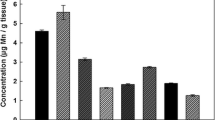Abstract
Al is found in the developing conceptus, but little information is available concerning its tissue distribution and its changes in concentration with age. Because Al has affinity for many of the same biological ligands as the essential mineral cations Ca, Mg, Zn, Fe, and Mn, we hypothesized that Al might show a pattern of developmental concentrations that was similar to one or more of these elements in the brain, a major target of Al toxicity. Concentrations of Al, Ca, Mg, Zn, Fe, and Mn were measured in spinal cord, brainstem, cerebellum, and forebrain of guinea pig fetuses on gestation day (GD) 30 and 45, at birth, and on postnatal day (PND) 3, 6, and 12. Dams were fed commercial guinea pig chow, which contained 47 μg Al/g. Tissue Al and Mn were measured with electrothermal atomic absorption spectrophotometry (ETAAS), and the other elements with inductively coupled axial plasma spectroscopy (ICAP-AES). Al concentrations in the brain regions were highest in spinal cord, brainstem, and cerebellum, and decreased during late gestation and lactation. Al did not show marked increases in regional brain concentrations during the final third of gestation as did Fe, Mg, and Zn. In contrast to Fe and Ca, Al did not accumulate in placenta. Al was the only element to show higher concentrations in spinal cord than in any other tissue at birth. In summary, the tissue distribution of Al did not follow that of essential cations as examined in this study.
Similar content being viewed by others
References
E. H. Jeffery, Biochemical mechanisms of aluminum toxicity,Hand Exp. Pharmacol. 115, 139–162 (1994).
E. H. Jeffery, K. Abreo, E. Burgess, J. Cannata, and J. B. Greger, Systemic Al toxicity; effects on bone, hematopoietic tissue, and kidney,J. Toxicol. Environ. Health,48, 649–666 (1996).
G. H. Mayor and M. Burnatowska-Hledin, The metabolism of aluminum and aluminum-related encephalopathy,Semin. Nephrol. 6, 1–4 (1986).
M. S. Golub and J. L. Domingo, What we know and what we need to know about developmental aluminum toxicity,J. Toxicol. Environ. Health,48, 585–597 (1996).
J. L. Domingo, Reproductive and developmental toxicity of aluminum: a review,Neurotoxicol. Teratol. 17, 515–521 (1995).
J. M. Donald, M. S. Golub, M. E. Gershwin, and C. L. Keen, Neurobehavioral effects in offspring of mice given excess aluminum in diet during gestation and lactation,Neurotoxicol. Teratol. 11, 341–351 (1989).
M. B. Bierings, M. R. M. Baert, H. G. van Eijk and J. P. van Dijk, Transferrin receptor expression and the regulation of placental iron uptake,Mol. Cell. Biochem. 100, 31–38 (1991).
D. A. Moutafchiev, L. M. Sirakov, and A. S. Naidu, Binding of mouse and rabbit iron-59 transferrins to lactating mouse mammary epithelial cells,J. Dairy. Sci. 74, 2959–2964 (1991).
J. P. van Dijk, F. G. van der Zande, M. J. Kroos, J. S. Starreveld, and H. G. van Eijk, Number and affinity of transferrin-receptors at the placental microvillous plasma membrane of the guinea pig: influence of gestation age and degree of transferrin glycan chain complexity,J. Dev. Physiol. 19, 221–226 (1993).
R. R. Anderson, Trace elements in milk of guinea pigs during a 20-day lactation,J. Dairy Sci. 73, 2327–32 (1990).
M. S. Golub, B. Han, and C. L. Keen, Iron and manganese uptake by offspring of lactating mice fed a high aluminum diet,Toxicology 109, 111–118 (1996).
M. S. Golub, B. Han, and C. L. Keen, and M. E. Gershwin, Developmental patterns of aluminum in mouse brain and interactions between dietary aluminum excess and manganese deficiency,Toxicology 81, 33–47 (1993).
USPHS. Guide to the Care and Use of Laboratory Animals. Bethesda, MD, National Institutes of Health, NIH publication 85-23, 1985.
M. S. Golub, B. Han, C. L. Keen, and M. E. Gershwin, Effects of dietary aluminum excess and manganese deficiency on neurobehavioral endpoints in adult mice,Toxicol. Appl. Pharmacol. 112, 154–160 (1992).
J. P. Scott, The embryology of the guinea pig. I. A table of normal development,Am. J. Anat. 60, 397–432 (1937).
J. Dobbing and J. Sands, Growth and development of the brain and spinal cord of the guinea pig,Brain Res. 17, 115–123 (1970).
E. M. Sierra, T. K. Rowles, J. Martin, G. R. Bratton, C. Womac, and E. Tiffany-Castiglioni, Low level lead neurotoxicity in a pregnant guinea pigs model: neuroglial enzyme ativities and brain trace metal concentrations,Toxicology 59, 81–96 (1989).
J. M. Cranmer, J. D. Wilkins, D. J. Cannon, and L. Smith, Fetal-placental-maternal uptake of aluminum in mice following gestational exposure: effect of dose and route of administration,Neurotoxicology 7, 601–608 (1986).
R. A. Yokel, Toxicity of aluminum exposure during lactation to the maternal and suckling rabbit,Toxicol. Appl. Pharmacol. 75, 35–43 (1984).
G. Muller, M.-F. Hutin, D. Burnel, and P. R. Lehr, Aluminum transfer through milk in female rats intoxicated by aluminum chloride,Biol. Trace Element Res. 34, 79–87 (1992).
P. Zatta, F. Cervellin, M. Favarato, M. Gerotto, and G. Mattiello, Microelemental concentration in the ontogenesis of rat brain,Trace Elements Electrolytes 11, 143–147 (1994).
Author information
Authors and Affiliations
Rights and permissions
About this article
Cite this article
Golub, M.S., Han, B. & Keen, C.L. Developmental patterns of aluminum and five essential mineral elements in the central nervous system of the fetal and infant guinea pig. Biol Trace Elem Res 55, 241–251 (1996). https://doi.org/10.1007/BF02785283
Received:
Accepted:
Issue Date:
DOI: https://doi.org/10.1007/BF02785283




